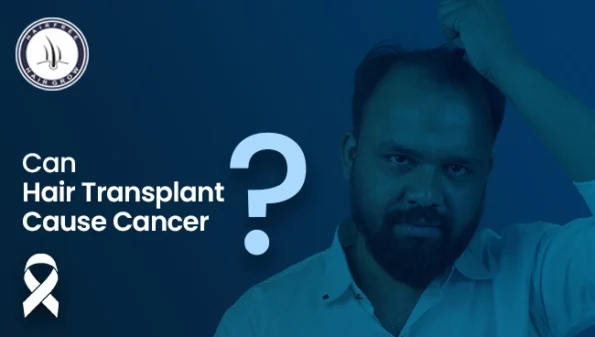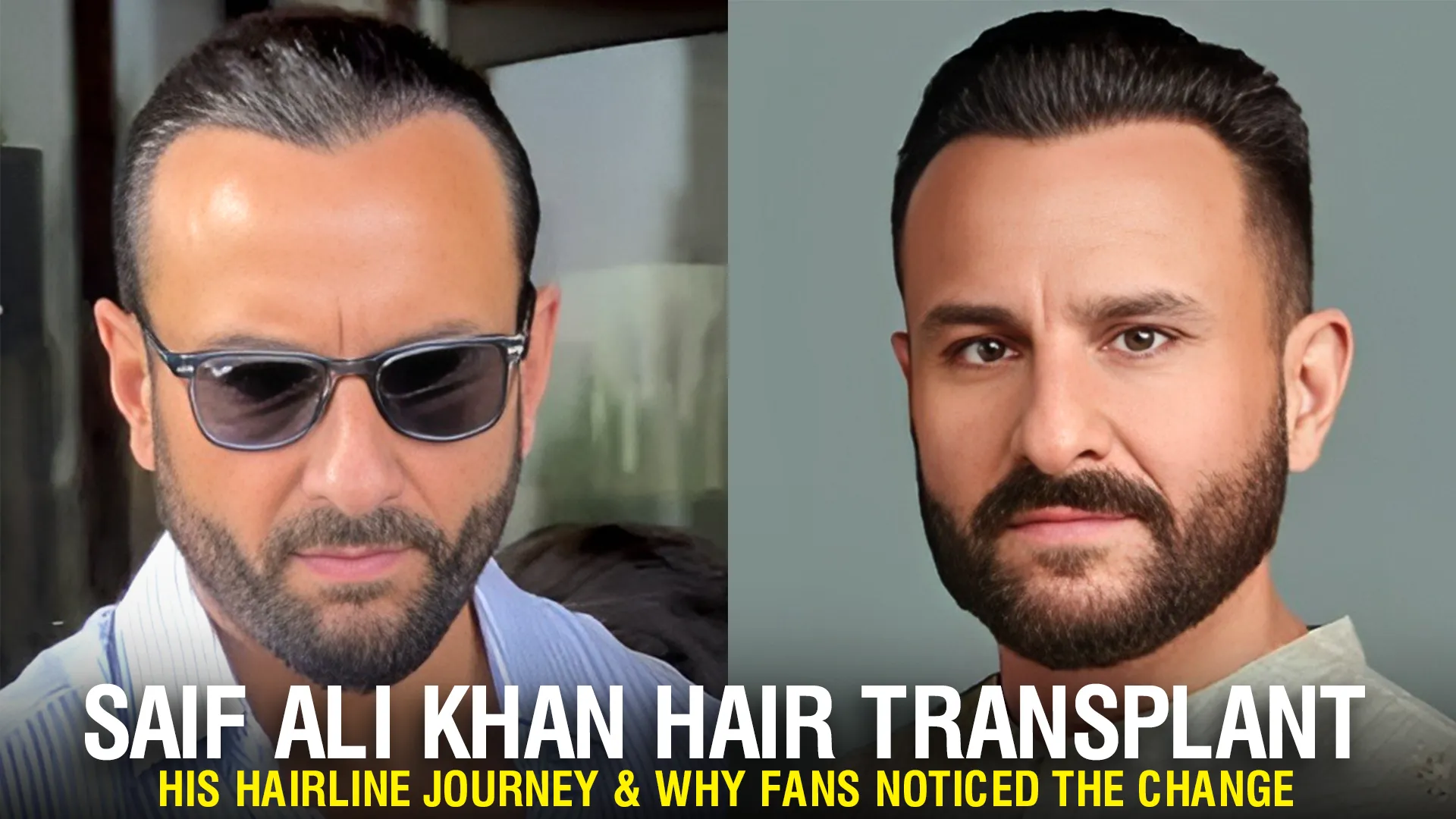No, hair transplants do not cause cancer; this is a common myth with no scientific or medical evidence to support it.
Hair loss has become a significant concern for many people who value their appearance, and hair transplant is the only permanent solution to this issue. However, despite its widespread effectiveness and popularity, there are various myths circulating online, including one that claims a connection between hair transplants and cancer.
Continue reading to unravel the truth behind these misconceptions and discover the facts about the rejuvenating journey. Can Hair Transplant Cause Cancer? Facts You Need to Know.
Do Hair Transplants Cause Cancer?
Simply, no. A hair transplant is a surgical solution that involves the intricate relocation of healthy hair follicles from a donor area to the region affected by baldness. This minimally invasive procedure carries no carcinogenic risks, and it’s important to emphasize that surgical interventions in hair transplants do not contribute to cancer development.
Instead, cancer risk is often linked to external factors such as:
- Prolonged exposure to harmful radiation
- Inadequate and unhealthy diet
- Smoking and alcohol consumption
- Lack of physical activity
- Environmental pollution and toxins
There has been no credible scientific evidence that links hair transplants with cancer. In fact, organizations like the American Academy of Dermatology have recognized hair transplantation as a safe and effective solution for hair restoration when performed by a qualified surgeon.
What Is a Hair Transplant?
Before addressing the safety myths, let’s understand what a hair transplant really is.
A hair transplant is a surgical procedure in which hair follicles are moved from one part of the scalp (usually the back or sides of the head) to areas experiencing hair loss. The two most widely used techniques include:
- FUT (Follicular Unit Transplantation): A strip of scalp is removed from the donor site and divided into individual follicular units, which are then implanted into the balding areas.
- FUE (Follicular Unit Extraction): Hair follicles are extracted one by one using advanced tools and directly implanted into the recipient area. This method is less invasive and leaves minimal scarring.
Both methods are safe, effective, and widely used across the globe.
What Are the Side Effects of Hair Transplant?
Hair transplant is a safe and minimally invasive procedure, though it does come with certain risks. These risks include minor issues like bleeding, swelling, and folliculitis, as well as more severe complications like nerve damage, dermal cysts, and infection.
However, it’s important to remember that the likelihood of these risks occurring is relatively low, especially if you choose a qualified surgeon and follow a proper aftercare routine. Following these steps significantly reduces the chances of complications and achieves the desired results.
Common Risks of Hair Transplant
- Swelling & Bleeding
- Shedding (temporary hair fall after transplant, also known as shock loss)
- Nerve Damage (rare and usually temporary)
- Folliculitis (inflammation of follicles, treatable with medication)
- Infection (rare with proper hygiene and aftercare)
- Dermal Cyst (uncommon, can be treated easily)
Are There Any Long-Term Effects of a Hair Transplant?
So, when it comes to hair transplants, most side effects are usually temporary and will disappear within a month or so. But in rare cases, some side effects like dermal cysts, numbness, or shock loss could stick around a bit longer.
To lower the chances of these risks, it’s super important to pick a skilled surgeon and a clean clinic. Remember, proper care before and after the transplant is key to getting those natural-looking results.
What About Short-Term Effects?
In the short term, you might experience some bleeding, discomfort, swelling, shedding, numbness, folliculitis, or dermal cysts after the procedure.
It’s crucial to take good care of the donor area wounds to prevent excess bleeding, as scabs will form there soon. To help with a smooth healing process, follow the clinic’s aftercare tips carefully.
Using special medical shampoo and foam lotion meant for aftercare, while following the washing instructions, will help the scabs naturally come off.
Myth vs Fact: Hair Transplants and Cancer
Many people hesitate to undergo hair transplants due to myths surrounding cancer. Let’s separate facts from fiction:
Myth 1: “Hair Transplants Cause Cancer.”
The claim: Moving follicles might trigger cancerous changes.
What the science says: A hair transplant simply relocates your own hair follicles; it doesn’t alter DNA or add carcinogens. Standard medical references list surgical risks like infection, scarring, shock loss, or poor growth, but not cancer. Choosing a trained, board-certified specialist reduces complications.
What to do: Verify your surgeon’s credentials and ask them to explain risks/benefits for your case.
Verdict: False. No credible evidence links hair transplantation itself to cancer.
Myth 2: “Anesthetics and Chemicals Used During Transplants are Carcinogenic.”
The claim: Local anesthetics, antiseptics, or graft-holding solutions raise cancer risk.
What the science says: Clinics use regulated, widely studied agents (e.g., local anesthetics, sterile saline). The main proven risks are allergy or local reactions, not cancer. Safe outcomes are strongly tied to qualified professionals and proper protocols.
What to do: Disclose allergies, meds, and past reactions during your consult; ask exactly what’s used.
Verdict: False. With standard, approved products in trained hands, there’s no evidence of cancer risk.
Myth 3: “Devices Used in Hair Transplant Expose You to Harmful Radiation.”
The claim: Surgical tools or magnifiers emit radiation that can cause cancer.
What the science says: Hair transplant tools don’t use ionizing radiation (the kind that can damage DNA). Only ionizing radiation (e.g., X-rays, gamma rays) is a proven cancer risk; visible light and similar non-ionizing sources are not.
What to do: If any imaging is suggested (rare), ask whether it uses ionizing radiation.
Verdict: False. The procedure does not expose you to cancer-causing radiation.
Myth 4: “Low-Level Laser Therapy (LLLT) for Hair Growth can Trigger Cancer.”
The claim: Red/near-infrared lasers “wake up” cancer cells.
What the science says: LLLT devices for hair loss use non-ionizing light (visible red/near-IR). Several systems have FDA 510(k) clearance for promoting hair growth; clinical reviews report safety when used as directed. Non-ionizing light lacks the energy to break DNA bonds the way ionizing radiation does.
What to do: Use only cleared devices under clinician guidance and follow manufacturer protocols.
Verdict: False. No evidence LLLT raises cancer risk when properly used.
Myth 5: “Hair-Loss Medicines (Finasteride/Minoxidil) Cause Cancer.”
The claim: Supporting meds around transplantation might increase cancer risk.
What the science says:
Minoxidil: No credible evidence links topical minoxidil to cancer
Finasteride: Large trials (e.g., PCPT) showed an overall reduction in prostate cancer diagnoses, with early concern about more high-grade tumors. Subsequent analyses indicate that “high-grade” signal was likely detection/measurement bias, not a causal effect; authoritative summaries reflect this nuance. Always discuss PSA monitoring because finasteride lowers PSA levels.
What to do: Talk with your doctor about personal/family history, prostate screening, and side effects.
Verdict: Mostly false/misleading. Current evidence does not show these meds cause cancer; finasteride requires informed monitoring.
Myth 6: “Stress From Hair Loss or Surgery Causes Cancer.”
The claim: Psychological stress directly leads to cancer.
What the science says: Leading cancer agencies say there’s no clear evidence that stress directly causes cancer. Stress can indirectly raise risk by driving unhealthy behaviors (smoking, alcohol, poor sleep/activity) and may affect outcomes in people who already have cancer. Managing stress is still important for overall health and recovery.
What to do: Prioritize sleep, exercise, and support; if needed, seek counseling, which improves quality of life even if it doesn’t change incidence.
Verdict: False as a direct cause. Focus on healthy habits that truly affect risk.
Myth 7: “Scar Tissue or Trauma From Grafts can ‘Turn Into’ Cancer.”
The claim: Tiny recipient-site incisions become cancerous later.
What the science says: Standard references for hair transplant risks do not include cancer. Transplant sites are small, superficial wounds that typically heal quickly. Routine skin checks are still smart for everyone, especially if you have a history of skin cancer, but the transplant itself isn’t a known carcinogenic trigger.
What to do: Practice sun protection, watch for new/non-healing lesions, and keep regular dermatology check-ups.
Verdict: False. Normal post-transplant healing does not convert to cancer.
Can Cancer Patients Get a Hair Transplant?
It’s also important to understand why hair loss happens in the first place. Some of the common causes include:
- Genetics (Androgenic Alopecia / Pattern Baldness)
- Hormonal changes (thyroid issues, PCOS, menopause)
- Medical treatments (like chemotherapy)
- Stress & lifestyle habits
- Poor diet and nutritional deficiencies
Hair transplants address genetic and patterned baldness effectively, but they are not a cure for every type of hair loss. Consulting a dermatologist or hair specialist is crucial before choosing surgery.
Benefits of Hair Transplants
Despite the myths, hair transplants offer life-changing benefits:
- Permanent Solution to hair loss
- Natural-Looking Results when performed by experts
- Low Maintenance compared to wigs or topical products
- Boosted Self-Confidence and improved mental wellbeing
Conclusion: Hair Transplants Are Safe and Do Not Cause Cancer
Hair transplants are a safe, effective, and permanent solution for those struggling with hair loss. The idea that they can cause cancer is a myth with no scientific backing. The only risks associated are typical surgical ones like infection, swelling, or scarring, which can be minimized by choosing a skilled surgeon and following proper aftercare.
If you are considering a hair transplant, consult a qualified professional, ensure the clinic follows medical safety standards, and take care of your health. That way, you can confidently embrace the journey towards a fuller head of hair without the fear of cancer.
FAQs
1. Can hair transplants cause infection?
Yes, there is a small risk of infection if post-surgical care is not followed. However, with proper hygiene and by taking prescribed medications, infections are rare.
2. Is there a risk of hair loss after a transplant?
Some patients experience temporary “shock loss,” where transplanted or existing hair falls out. This is normal and new growth usually begins within a few months.
3. Do hair transplants cause cancer in the long term?
No. There is no scientific evidence linking hair transplants to cancer or any life-threatening condition.
4. Are hair transplants permanent?
Yes. Transplanted hair follicles are taken from areas resistant to balding (like the back of the scalp), which usually last a lifetime. However, proper care is still important to maintain overall hair health.
5. Is the procedure painful, and how long does it take to see results?
The procedure is not very painful because local anesthesia is used. Most patients feel only mild discomfort. New hair growth usually starts in 3–6 months, with full results visible in 9–12 months.
Written By
MBBS, DDV
Dr. Shridevi Lakhe, a renowned hair restoration expert, specializes in addressing patient concerns, including whether hair transplants can cause cancer. Her extensive research and clinical experience have contributed significantly to debunking myths surrounding hair transplant safety.
Disclaimer
We’ve made all possible efforts to ensure that the information provided here is accurate, up-to-date and complete, however, it should not be treated as a substitute for professional medical advice, diagnosis or treatment. See Detailed Disclaimers Here.





